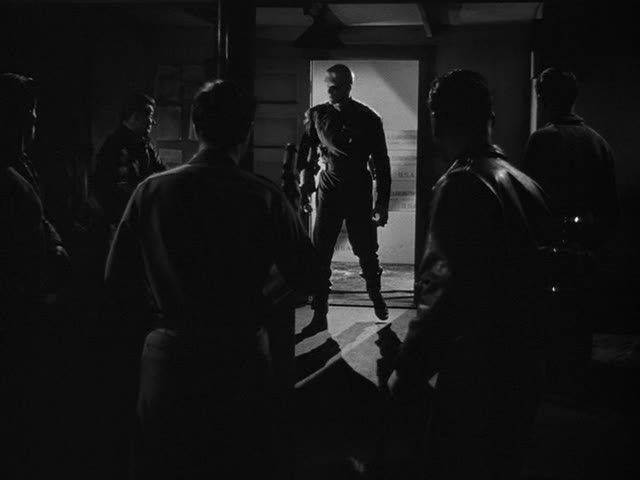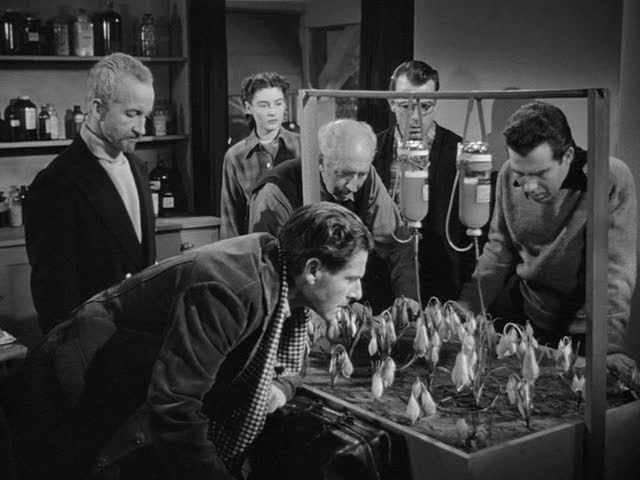
The Thing From Another World is one of the great classics of sci-fi horror, a taut minimalist study of a group of military men and scientists under pressure, hemmed in by an extraterrestrial monstrosity that crash-landed at a remote research station near the north pole. The film was produced by Howard Hawks, and though ostensibly the first directorial feature of editor Christian Nyby, it's well-known that Hawks was on the set giving, at the very least, comprehensive advice, and most likely taking over the directing chair for himself. Certainly, though the science fiction premise is unlike anything else in Hawks' filmography, the film bears the director's aesthetic signature and deals with some of his typical concerns. Indeed, the alien monster appears only sporadically, in brief flashes, mostly obscured by darkness. The film's emphasis is not on its horror elements but on the dynamics within the tight-knit professional groups doing hard, dangerous work in the midst of this snowbound wasteland.
Among these men is Air Force Captain Patrick Hendry (Kenneth Tobey), who fulfills the role of the romantic hero even though, like Hawks' Air Force before it, this is a film where individual characters matter far less than the group as a whole. The research station is populated mostly with minor, little-known actors (Dewey Martin, James R. Young, Robert Nichols, etc.), including several recurring Hawks bit players, which only enhances the impression that the individual personalities of these men are not meant to stand out. They exist only as a part of the group and, symbolically, as members of the human race. Hendry and his crew of military men are summoned to a research station near the north pole after a mysterious aircraft crashes with a tremendous impact some fifty miles away from the station. The crash immediately begins triggering strange phenomena: communications are disrupted and measuring instruments go haywire, while Geiger counters pick up traces of radiation from the vicinity of the crash. Hendry's men are summoned by the brilliant scientist Dr. Carrington (Robert Cornthwaite) to help investigate the crash site and determine what happened. Of course, the crashed aircraft is no ordinary plane but a flying saucer, and though the military accidentally destroy it while trying to free it from the ice that hardened around it, they do recover the frozen body of one of the craft's inhabitants, a massive alien trapped in a block of ice.
Of course, soon enough the alien escapes and begins stalking around the base, largely unseen, feeding on the blood of the base's human and canine inhabitants. But the film's focus is not so much on the horror of the alien's violence but on the effect his mere existence has on the people at the base. Carrington sees the creature as a specimen, an unprecedented opportunity for scientific discovery and new knowledge. Hendry sees the alien as a threat to be contained and possibly eliminated. And the eager reporter Scotty (Douglas Spencer) sees only a phenomenal story, one that unfortunately he isn't able to tell thanks to military stalling and spotty communications. The alien itself is rarely shown, even after it emerges from its icy prison. The first time it attacks one of the base's soldiers, it's just a hint of a shadow falling across the man, who turns and fires his gun at the offscreen monster. Later, the alien, played through bizarre makeup by James Arness, is only seen from a distance or bathed in shadows, its hulking menace enhanced by this indirectness.

Hawks and Nyby spend much more time with the gathered inhabitants of the base, who huddle together in tight circular compositions, clustered around tables where papers and scientific demonstrations and endless cups of coffee hold their interest as they discuss what to do about the alien. These tight, cluttered compositions are purely Hawksian and perhaps the most obvious indication of Hawks' influence on the film. Despite the looming threat, the dialogue is crisp and light, with the actors delivering their lines at Hawks' characteristic brisk pace. The camaraderie between the men, especially the military men, is established through their continual exchanges of jokes and banter, particularly at the expense of Hendry, who the men rib for his interest in the scientists' assistant Nikki (Margaret Sullivan). Nikki is a typically Hawksian woman, strong and assertive and capable of verbally sparring with Hendry and even pulling jokes on him just like one of the boys. She even gets the drop on him, tying his hands behind his back for some playful S&M foreplay, feeding him drinks and then giving him a kiss once he's passive and restrained.
In the film's second half, Hawks and Nyby slowly build the tension, compressing the station's staff into tighter and tighter spaces, keeping the monster mostly out of sight but allowing his unseen presence to spread terror throughout the compound. There's also the queasy fascination of such unforgettable images as the severed hand that slowly comes back to life and begins flexing its fingers, or the bed of alien plant buds, fed on human plasma, that throb as though breathing and cry like hungry babies. The special effects are crude and simple, but these roughly crafted images contribute to the film's minimalist intensity. Considering that this was Hawks' sole contribution to the sci-fi or horror genres, he proves startlingly adept at it. An assault on the creature with kerosene and a flare launcher in a small, dark room is awash with frenzied terror (as well as being a very early experiment in setting stuntmen on fire), with the flaming alien careening around the confined space, flailing its arms around and unleashing an inhuman howl.
Towards the beginning of the film, there are several stark exterior sequences in windy, barren white landscapes with snow blowing past in flurries. As the film progresses it becomes increasingly claustrophobic and enclosed, culminating in the final sequence where the group backs into a corner within the isolated, cut-off station, waiting for the alien to come for them, their cold breath letting out trails of steam in the chilly air. The Thing From Another World is a fascinating, quietly intense masterpiece, with Hawks bringing his unique perspective to the sci-fi horror genre and truly making it his own.







0Awesome Comments!